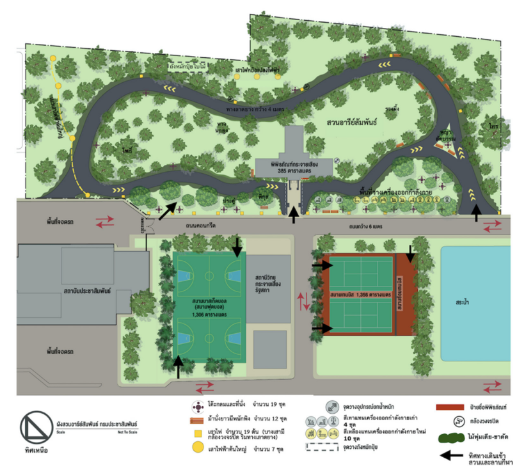Design Guideline for Bangkok Neighborhood Park Furniture Supporting Good Life Quality and Creative activities for urban living: A Case Study of Areesamphan Park
Main Article Content
Abstract
The research article presents the study results and the design guideline for Bangkok neighborhood park furniture in the pre-design phase. Furniture designers and public park officers can apply the guideline for creating park furniture suitable for users and locations. The study area was Areesamphan park at the government public relations department. There were 2 phases of the research method. The first phase was to study existing Areesamphan park, furniture uses, users’ needs,and case study. Data was collected by observation and 150 questionnaires with interview. The second phase was the pre-design thinking process to develop the design guideline for solving existing furniture’s problems and creating new furniture concepts. There are 3 important conclusions. First, existing furniture should be improved and neccessary park furniture should be provided for solving functional problems. Second, the new park furniture design should focus mainly on functions, green design or harmony with nature, and design identity respectively. Third, the design for Bangkok neighborhood park furniture should consider functional problems, users’ needs, and equitable uses.
Downloads
Article Details

This work is licensed under a Creative Commons Attribution-NonCommercial-NoDerivatives 4.0 International License.
All material is licensed under the terms of the Creative Commons Attribution 4.0 International (CC-BY-NC-ND 4.0) License, unless otherwise stated. As such, authors are free to share, copy, and redistribute the material in any medium or format. The authors must give appropriate credit, provide a link to the license, and indicate if changes were made. The authors may do so in any reasonable manner, but not in any way that suggests the licensor endorses you or your use. The authors may not use the material for commercial purposes. If the authors remix, transform, or build upon the material, they may not distribute the modified material, unless permission is obtained from JARS. Final, accepted versions of the paper may be posted on third party repositories, provided appropriate acknowledgement to the original source is clearly noted.
References
Department of Local Administration. (2019). Standard of Recreation Public Spaces. Retrieved from http://www.dla.go.th/servlet/EbookServlet?_mode=detail&ebookId=18&random=1362642482298.
Department of Public Work, Bangkok Metropolitan Administration. (2013). Facilities for all in society. Bangkok: Department of Public Work, Bangkok Metropolitan Administration.
Environment Department and Strategy and Evaluation Department, Bangkok Metropolitan Administration. (2016). Database and monitoring & evaluation system for the green area of Bangkok: Definition of 7 green areas. Retrieved from http://203.155.220.118/userfiles/files/park%20type.pdf.
Lee, B.Y.H., Chan, D.L.H., & Tang, M.X. (2013). Park seating furniture design in hong kong : a case study of inclusive design and its relation to user interaction. Retrieved from https://www.researchgate.net/publication/267042345_Park_Furniture_Design_in_Hong_Kong_A_Case_Study_of_Inclusive_Design_and_its_Relation_to_User_Interaction.
Luximon, Y., Kwong, H.Y., & Tai, Y.Y. (2015). User preferences of urban park seating pattern in hong kong. Procedia Manufacturing, 3, 4273-4278. DOI: 10.1016/j.promfg.2015.07.415.
Marcus, C. C., & Francis, C. (Eds.). (1998). People places: Design guidelines for urban open space (2nd ed.). New York: John Wiley & Sons.
Panero, J. & Zelnik, M. (1979). Human Dimension & Interior Space: A Source Book of Design Reference Standards. New York: Whitney Library of Design.
Strategy and Evaluation Department, Bangkok Metropolitan Administration. (2014). 20-year Development Plan (2013 – 2032). Retrieved from http://www.bangkok.go.th/upload/user/00000130/Logo/Document/1PlanDevelopBangkok20Year2556-2575.pdf.
Strategy and Evaluation Department, Bangkok Metropolitan Administration. (2018). 20-year Development Plan: Round 2 (2018 – 2022). Retrieved from http://203.155.220.174/uploads/File/752.pdf.
Wanarat, L. (2000). Healthy Cities. Retrieved from http://advisor.anamai.moph.go.th/main.php?filename=tamra_cities.


